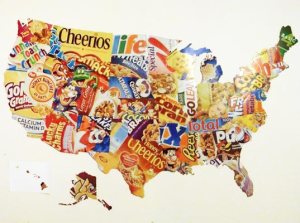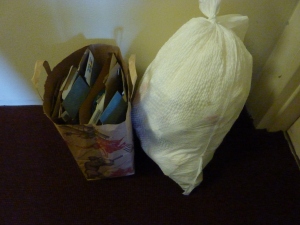After 4 weeks, I would re-soundingly say my PSP goals were a success.  I significantly reduced the amount of plastic waste I threw away on a daily bases and more importantly, I feel as though I’m much more aware of what I buy and the environmental consequences they pose. Although I did relapse a bit here and there as I did have to resort to using disposable plastic bags on a few grocery trips, I’m making sure they’re reused as dog dropping bags or in some other capacity around our house. Or better yet, I could drop them off the next time I go to the store in a plastic bag recycling bin. This experience has really shown me it doesn’t take much more effort to reduce, reuse, and recycle many of the items you’d normally throw away and it feels great knowing your actions, although they may be small in the grand scheme of things, have positive effects on the environment instead of adverse ones.
I significantly reduced the amount of plastic waste I threw away on a daily bases and more importantly, I feel as though I’m much more aware of what I buy and the environmental consequences they pose. Although I did relapse a bit here and there as I did have to resort to using disposable plastic bags on a few grocery trips, I’m making sure they’re reused as dog dropping bags or in some other capacity around our house. Or better yet, I could drop them off the next time I go to the store in a plastic bag recycling bin. This experience has really shown me it doesn’t take much more effort to reduce, reuse, and recycle many of the items you’d normally throw away and it feels great knowing your actions, although they may be small in the grand scheme of things, have positive effects on the environment instead of adverse ones.
Overview of my 3 Goals
Making the switch to reusable bags: This goal was by far the hardest for me to keep. I started out with a plan to store reusable cloth bags in a few locations such as my car so I wouldn’t forget them on grocery trips and it worked great. The problem arose when I went to the store more spur of the moment like if I needed a few things for dinner or some beer and drinks for a hot day. Instead of increasing my supply of cloth bags each time this happened, I just bit my lip and used a plastic bag or two.
Using Tupperware instead of disposable Ziploc bags: Very easy alternative choice to make and one that kept my food fresher and more organized in my backpack. It’s actually quite amazing that ever since I started my PSP, I haven’t used a single Ziploc bag. It helps that we currently don’t have any in our house but I also went against using them earlier in the week when I went hiking with my family. Instead I just threw everything in a single Tupperware container rather than wasting a couple disposable bags.
Reusable water bottles over disposable ones: Another achievable goal that was simple to make the switch to. We have loads of reusable bottles in our cupboards that got infrequent use so it was only a matter of making sure I always brought one with me to school. Like I mentioned in my last post, I also took things a step further and instead of buying single bottles of Gatorade at the store, I decided to buy a large tub of Gatorade powder. Now I can mix my own Gatorade at home and pour it in reusable bottles in lieu of continually purchasing more single-use plastic bottles that I would ultimately end up recycling.
The Impact of Reducing Plastic Use
Environmentally, it all starts with what I buy as nearly everything is eventually thrown out. By reducing plastic waste at the source, less will have the chance of being released into the environment and less energy and resources would be devoted to recycling. Plastic bags in particular use up 4% of the world’s oil and gas in their production while pumping out tons of greenhouse gases annually. Likewise, plastic bottle production creates harmful emissions and they are oftentimes harder to recycle fully as the bottles themselves are a combination of different plastics. They have to endure many reduction cycles to totally break down all the kinds of plastic. Most plastics aren’t biodegradable and are extremely durable, allowing them to settle in our environment for thousands of years (Hopewell, 2009). Just knowing I practice more of an integrated waste management system where I try to recycle everything I can feels me with joy and more knowing that my recycling habits are starting to rub off on my roommates.
Socially, I know my newfound desire to limit my plastic waste and practice the three Rs (reduce, reuse, recycle) is effecting everyone around me. I’ve got my roommates thinking more about their ecological footprints, set up additional recycling bags in our house to encourage recycling over throwing things away, and convinced friends to buy their own set of reusable cloth bags. A few days ago, I even persuaded a woman in the checkout line at Winco to purchase a few reusable bags after she saw our stack in the cart. Although it’s still fairly uncommon to see people bring their own reusable bags to the super market, it definitely stands out when you see it and no doubt raises the eyebrows of other shoppers, hopefully making them think about changing their own habits. I’m curious to see how the new plastic bag ban in Corvallis will shape up when it takes effect next year. While it may just turn into a minor inconvenience for people to pay an extra $0.05 per paper bag, it has the chance to make a real impact on the disposable plastic industry if people make the switch to reusable bags and use them for many purposes (Hall, 2012).
Overall, I’d estimate my monthly savings to be around $5 by not buying any disposable plastic bags. While it’s a modest savings, soon I’ll increasing that amount as my reusable cloth bags will start earning me money since I’ve used them about 7 times since I bought them (they cost $0.80 each initially but Winco credits you $0.10 per use). If more people started using reusable bags too, that would definitely send a message as less would be produced and the annual costs retailers would spend on them, about $4 billion a year, would decrease. It would also immensely reduce the amount of bags littering the environment, since only about 5% of disposable bags get recycled, while likewise improving ecosystems like oceans and streams where bags tend to end up (reuseit.com, 2012). Lessening emissions from plastic producing plants additionally diminishes atmosphere pollution and improves overall health for both humans and animals as plastic toxins aren’t passed up the food chain as much as before.
Continuing the Good Fight
Reflecting on my PSP, I don’t see why I’d stop working to depreciate my daily disposable plastic use now. It doesn’t require me to alter my lifestyle very much and it just makes sense to use what you already own like Tupperware containers instead of buying and going through loads of disposable Ziploc bags. Since the only real down for me was sometimes not having a reusable bag on hand during impromptu store runs, I really want to seek out and find a smaller reusable bag I can take with me anywhere. I noticed a few of my classmates had some that fit into small pouches so I’m excited to find something similar I can easily slip into a back pocket or toss effortlessly into my backpack.

While I think my PSP fit well into my daily routine, after looking over other student’s blogs, it’s clear that I could easily add further sustainable habits to it. Biking to school, limiting my water use during showers, and eating locally and/or organically more often are thing I’m certainly going to try to do more on a consistent bases. There are also many other small changes I could make to improve sustainability like air dry clothes and unplug most appliances and electronics when they aren’t in use.
Comprehensively, I thoroughly enjoyed learning more about becoming a more sustainable individual and just how much a simple action like reducing disposable plastic bag use can potentially improve environmental, social, and health conditions if widely practiced. It was shocking to learn about the Great Pacific Garbage Patch growing off our shores in the Pacific Ocean and how it’s actually the jobs of some people in lesser developed countries to sift through our trash for reusable and valuable items (Dorigo 2012). The numbers about recycling in the U.S. were further evidence that we’re still fairly ignorant about the recycling process with respect to other countries such as Norway and Austria which have committed to reduce their resource waste by 75% (Miller and Spoolman 429). While its encouraging cities around the U.S. like Portland and San Francisco have banned plastic bags in stores and are working to become more sustainable, this isn’t good enough. I personally want to see harsher bans on plastic bags and faster transitions to reusable bags. More stiff taxes and other measures should be implemented by our government. Ample money should also be devoted to environmental cleanup and restoration as our country is the #1 polluter in the world. I can only hope that during my lifetime our country will progress towards a more sustainable one. We need to stop thinking so economically for once and worry more about the harm we’re causing to mother Earth.

References
Dorigo, Enrico. Will Banning Plastic Bags Help The Environment? Science 2.0. Web. 24 Jan. 2012. <http://www.science20.com/enrico_dorigo/will_banning_plastic_bags_help_environment-75598>.
Facts about the Plastic Bag Pandemic. Reuseit.com. Web. 10 Aug. 2012. <http://www.reuseit.com/learn-more/top-facts/plastic-bag-facts>.
Hall, Bennett. City Council approves ban on plastic bags. Corvallis Gazette-Times. Web. 19 June 2012. <http://www.gazettetimes.com/news/local/article_a7e20cd2-b9ea-11e1-a3b1001a4bcf887a.html>.
Hopewell, Jefferson, Dvorak, Robert, and Edward Kosior. “Plastics recycling: challenges and opportunities.” Philosophical Transactions of the Royal Society (2009): v.364(1526). Web. 27 July, 2009. doi: 10.1098/rstb.2008.0311.
Miller, Tyler G., and Scott E. Spoolman. Environmental Science. 14th ed. Belmont: Brooks/Cole, 2010. Print.





















 Locally, it’s hard for a single person to make much of a dent in an enormous global problem like plastic recycling but I’m glad my new habits are rubbing off on my roommates. All of them are now taking reusable coffee mugs and water bottles to school and work, our recycling bags have been filling up about as fast as our garbage bin, and I’ve even lent them my reusable grocery bags for their shopping trips. Also, identical to what another student is doing, my roommate and I are taking things a step further and reusing most of our beer bottles for homebrews we’ll be making for the football season. I’m sure the recycling station staff at Fred Meyer’s will be grateful we’ll be stopping by less often and clogging up their glass machines (it always happens!!).
Locally, it’s hard for a single person to make much of a dent in an enormous global problem like plastic recycling but I’m glad my new habits are rubbing off on my roommates. All of them are now taking reusable coffee mugs and water bottles to school and work, our recycling bags have been filling up about as fast as our garbage bin, and I’ve even lent them my reusable grocery bags for their shopping trips. Also, identical to what another student is doing, my roommate and I are taking things a step further and reusing most of our beer bottles for homebrews we’ll be making for the football season. I’m sure the recycling station staff at Fred Meyer’s will be grateful we’ll be stopping by less often and clogging up their glass machines (it always happens!!).



